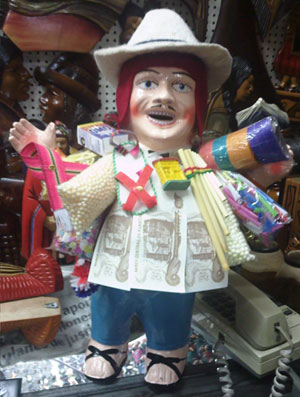According to Paredes Candia
Legend has it that the Ekeko of today is a reinterpretation of the Tiahuanakan idol by a young man in love whose name was Isidro Choquehuanca. The small idol was a going-away gift Isidro gave to Paulita, a pretty girl who had been sent to work at the home of the patrón’s daughter, Doña Josefa Ursula de Rojas Foronda, the wife of Brigadier Don Sebastián de Segurola, Governor and Commanding Officer of the city of La Paz and its surroundings.
The idol became popular in its current manifestation after the siege of the city of La Paz and the idol's participation in its salvation. The city had been surrounded for 5 months, and food and water were scarce. However, at the Brigadier’s home, Paulita was never hungry even though her masters were malnourished and starving. Paulita, moved by her masters’ concern for her, shared her secret with them and fed them with supplies of some mysterious origin.
Isidro was recruited into the army by Julian Apaza (Tupac Katiri) and was posted at an advance station on Calvary Hill. He stealthily crossed the lines to take food to his beloved.
station on Calvary Hill. He stealthily crossed the lines to take food to his beloved.
In order not to expose her beloved to greater danger, Paulita showed the idol to her masters, who accepted it during this time of distress and anxiety without asking for any explanation and thanked the native idol with great respect.
When the city was liberated by the arrival of the army, the Brigadier and his wife had not suffered extreme hunger as had the other residents.
Brigadier and Governor Don Sebastián de Segurola could not forget the small native talisman, which he felt protected him and his wife to the end. Therefore, by law, the fair that had been established to celebrate the founding of the city on October 20th was moved to January 24th. Above all, the trade and commerce of the Aymara fetish known as Ekeko was encouraged, but it took on the form as the model that the Governor had displayed, which was none other than Paulita’s. The Governor gave no reason for the talisman, but swore that whoever acquired it or took it to his or her home would have tremendous good luck.
Liberation of the city made possible a rebirth of the indigenous traditions under a new rule that moved towards a kind of sweet superstition full of optimism that was disseminated among all the people who were born or bred in the city of La Paz. And without trying to, Brigadier Segurola issued an ordinance that was destined to outlast the times of independence and the Republic because of its beautiful, harmless nature that deeply took root in the popular heart and soul.


